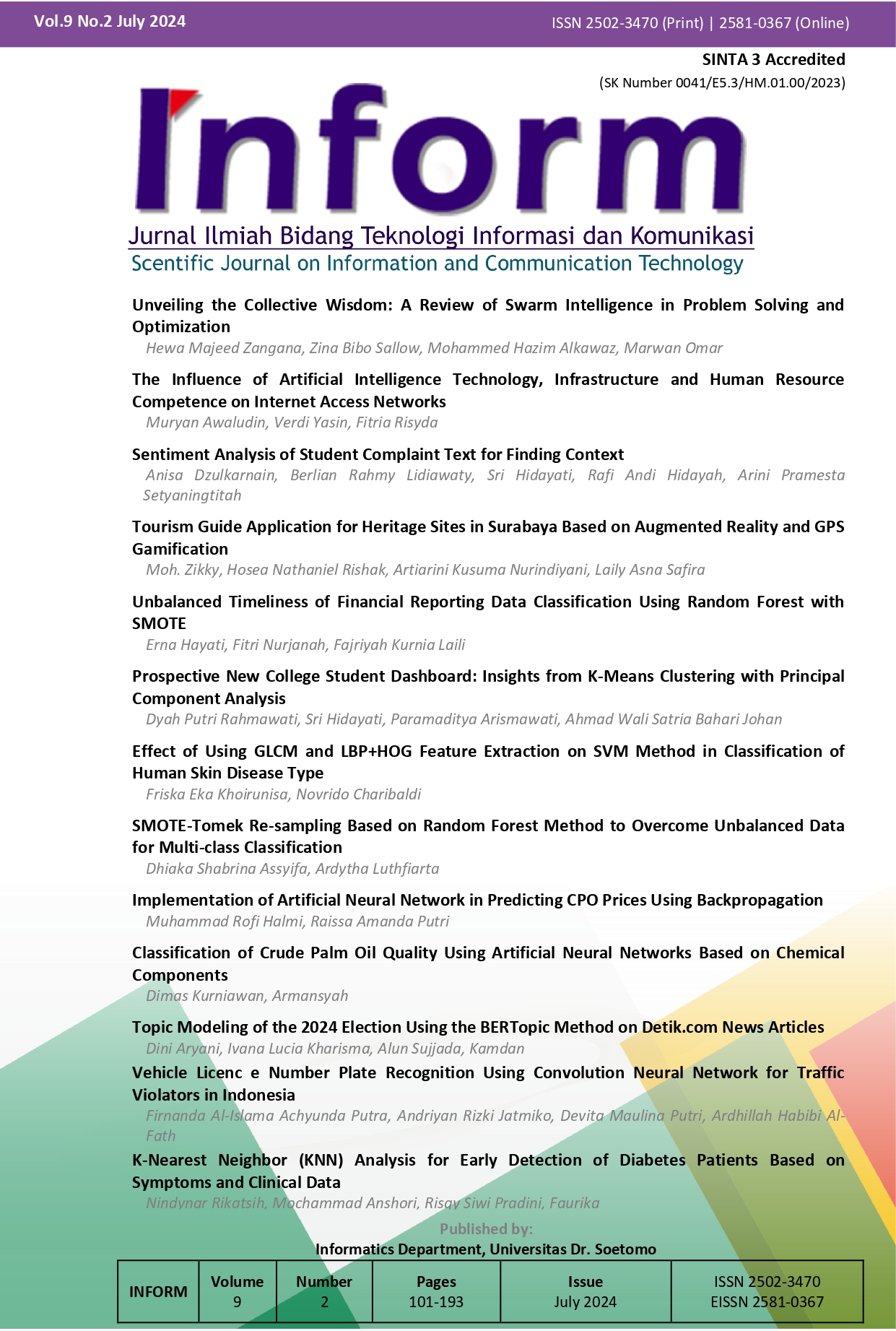Implementation of Artificial Neural Network in Predicting CPO Prices Using Backpropagation
 Abstract views: 193
,
Abstract views: 193
,
 PDF downloads: 133
PDF downloads: 133
Abstract
This research examines the development of a forecasting model for Crude Palm Oil (CPO) prices using artificial neural network algorithms, particularly the backpropagation algorithm. CPO, as Indonesia's main export commodity, has significant economic impacts and affects the income of oil palm farmers. Data on CPO prices taken from CIF Rotterdam from January 2019 to December 2023 were used in this study. The research method involved several stages, including data collection, pre-processing, model design, and model implementation using Python programming. The results of training the model using the backpropagation algorithm showed an error value of 0.537829578 after 1000 epochs, while evaluation using Mean Squared Error (MSE) showed an MSE value of 0.022709 during the training process and 0.017604 during the testing process. The model also produced predictions for CPO prices in the next three months: 932.578 for the first month, 949.568 for the second month, and 774.855 for the third month. These findings indicate that the developed model can predict future CPO prices with adequate accuracy, which can assist companies in making better financial decisions and managing risks associated with CPO price fluctuations.
References
D. Haryadi and R. Mandala, “Prediksi harga minyak kelapa sawit dalam investasi dengan membandingkan algoritma naïve bayes, support vector machine dan k-nearest neighbor,” IT Soc., vol. 4, no. 1, 2019, doi: 10.33021/itfs.v4i1.1181.
A. Amriana, A. A. Kasim, and M. Maghfirat, “Penentuan Harga Tandan Buah Segar (TBS) Kelapa Sawit Menggunakan Metode Fuzzy Logic,” Ilk. J. Ilm., vol. 12, no. 3, pp. 236–244, 2020, doi: 10.33096/ilkom.v12i3.619.236-244.
S. Kurnia Gusti and P. Cholidhazia, “Implementasi jaringan syaraf tiruan backpropagation untuk prediksi harga Crude Palm Oil (CPO),” 2021.
S. Anggriyani, M. Manuputty, A. Lewaherilla, and L. Bakarbessy, “Prediksi curah hujan di kota tual dengan menggunakan metode Backpropagation Predict of Rainfall in Tual City using the Backpropagation Method,” 2023.
E. P. C. Edi Ismanto, “Jaringan syaraf tiruan algoritma backpropagation dalam memprediksi ketersediaan komoditi pangan provinsi riau,” Rabit J. Teknol. dan Sist. Inf. Univrab, vol. 2, no. 2, pp. 196–209, Aug. 2017, doi: 10.36341/rabit.v2i2.152.
I. D. Yunanto, “Analisis Pengaruh Harga Spot Dan Harga Forward Terhadap Harga Dimasa Mendatang Komoditas CPO (Studi Pada Bursa Derivatif Malaysia Komoditas CPO),” p. 66, 2020.
M. As’ad, S. Sujito, and S. Setyowibowo, “Neural Network Autoregressive For Predicting Daily Gold Price,” J. Inf., vol. 5, no. 2, p. 69, 2020, doi: 10.25139/inform.v0i1.2715.
H. A. Fikri, “Prediksi Harga Emas Dengan Algoritma Backpropagation,” 2023.
S. Suparji, S. Sriyanto, and S. Lestari, “Metode Pendugaan Curah Hujan Dasarian Menggunakan Jaringan Syaraf Tiruan Dengan Algoritma Back-Propagation (Studi Kasus: Stasiun Klimatologi Pesawaran Lampung),” 2022.
A. A. Karia and I. Bujang, "Progress accuracy of CPO price prediction: Evidence from ARMA family and artificial neural network approach," Int. Res. J. Financ. Econ., vol. 64, no. April 2011, pp. 66–79, 2011.
P. B. Utomo and E. Utami, “Pendukung keputusan penerima dana desa dengan menggunakan metode promethee kecamatan godean kabupaten sleman,” 2019.
E. Lette, M. Zunaidi, and W. R. Maya, “Prediksi Penjualan Crude Palm Oil (CPO) Menggunakan Metode Regresi Linear Berganda,” J. Sist. Inf. Triguna Dharma (JURSI TGD), vol. 1, no. 3, p. 128, 2022, doi: 10.53513/jursi.v1i3.5106.
N. Nafi’iyah, “Penerapan regresi linear dalam memprediksi harga jual mobil bekas,” 2020.
A. Muhajirin and M. Yasir, “Penerapan Jaringan Saraf Tiruan Dengan Metode Backpropagation Untuk Memprediksi Tingkat Kelulusan Mahasiswa Perguruan Tinggi,” vol. 4, no. 1, pp. 214–224, 2024.
N. F. Hasan, K. Kusrini, and H. Al Fatta, “Peramalan Jumlah Penjualan Menggunakan Jaringan Syaraf Tiruan Backpropagation Pada Perusahaan Air Minum Dalam Kemasan,” J. Tek. Inform. dan Sist. Inf., vol. 5, no. 2, pp. 179–188, 2019, doi: 10.28932/jutisi.v5i2.1607.
B. C. Octariadi, “Pengenalan pola tanda tangan menggunakan metode jaringan syaraf tiruan Backpropagation,” J. Teknoinfo, vol. 14, no. 1, p. 15, Jan. 2020, doi: 10.33365/jti.v14i1.462.
Choiril Ichsan Damanik, Dedy Haratama, and Heru Satria Tambunan, “Penerapan JST Backpropagation Untuk Memprediksi Data Penerimaan Mahasiswa Baru Pada Universitas Simalungun,” Bull. Comput. Sci. Res., vol. 2, no. 1, pp. 25–33, 2021, doi: 10.47065/bulletincsr.v2i1.146.
M. F. Mubarokh, M. Nasir, and D. Komalasari, “Jaringan Syaraf Tiruan Untuk Memprediksi Penjualan Pakaian Menggunakan Algoritma Backpropagation,” J. Comput. Inf. Syst. Ampera, vol. 1, no. 1, pp. 29–43, 2020, doi: 10.51519/journalcisa.v1i1.3.
A. Suryadibrata and D. P. Chandra, “Implementasi Jaringan Saraf Tiruan Backpropagation untuk Pengenalan Karakter pada Dokumen Tercetak,” Ultim. Comput. J. Sist. Komput., vol. 11, no. 2, pp. 81–89, 2020, doi: 10.31937/sk.v11i2.1456.
Zaini Miftach, “Sistem pendukung keputusan pemilihan mahasiswa berprestasi menggunakan jaringan syaraf tiruan back propagation,” vol. 2, no. 1, pp. 53–54, 2019.
Copyright (c) 2024 Muhmmad Rofi Halmi, Raissa Amanda Putri

This work is licensed under a Creative Commons Attribution-ShareAlike 4.0 International License.
Authors who publish with Inform: Jurnal Ilmiah Bidang Teknologi Informasi dan Komunikasi agree to the following terms:
-
Authors retain copyright and grant the journal right of first publication with the work simultaneously licensed under a Creative Commons Attribution License (CC BY-SA 4.0) that allows others to share the work with an acknowledgment of the work's authorship and initial publication in this journal.
-
Authors are able to enter into separate, additional contractual arrangements for the non-exclusive distribution of the journal's published version of the work (e.g., post it to an institutional repository or publish it in a book), with an acknowledgment of its initial publication in this journal.
-
Authors are permitted and encouraged to post their work online (e.g., in institutional repositories or on their website) prior to and during the submission process, as it can lead to productive exchanges, as well as earlier and greater citation of published work.











